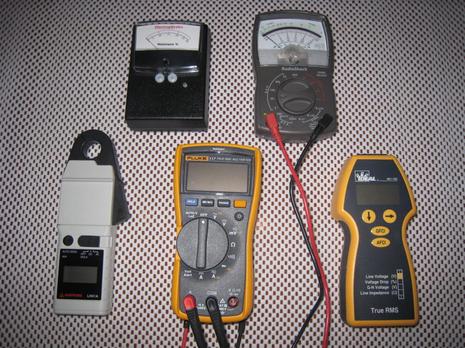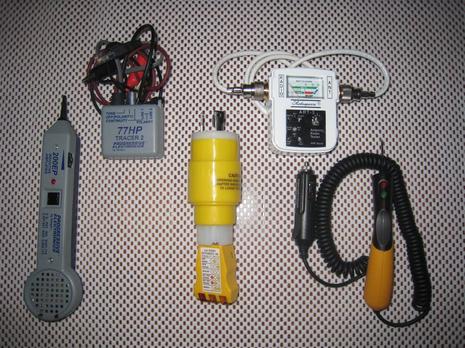Dan's Boat Tools, The Battery Operated Kind

Dan Corcoran: In the fall there were a lot of magazine articles on tools everyone should have on their boat including favorite tools, tools distance cruisers should have, unusual tools, multi purpose tools, and so forth. In this article I bring some focus to tools of the battery operated kind I use on my boat.
The most frightening tool to use is the Electrophysics CT-33 Moisture Meter in the top left side of the picture. If the meter on this tool moves much to the right, it's a good predictor of unpleasant drilling, epoxy, and sanding work in my future. Place this tool against the surface of a fiberglass deck, and rather quickly the contact sensor on the backside utilizes a capacitance based measurement to indicate how much moisture is on the other side of the fiberglass, in the wooden core below. Move this around the fiberglass and you can find how extensive a water penetration is and possibly trace it to the source. As unpleasant as the meter reading might be, it's far better to detect and resolve water leaks early, than have a boat surveyor warn away buyers or knock many thousands off the value of your boat when you go to sell it later.
The black analog multimeter above is a Radio Shack model 22-223. A very inexpensive piece of gear worth keeping aboard at all times. I like this one because the big display makes the volt and ohm markings readable from 3 feet away. If you're not a master of this $20 device, the rest of this article will be tough to follow although I do include below a good book recommendation.
Next is a digital multimeter. I strongly advise against the use of digital multimeters on boats, as they will waste your time with false readings. An exception is the Fluke 117 multimeter pictured above. This product has a low impedance measurement feature (Fluke LoZ) which overcomes the reasons most digital multi meters provide false readings on boats (induced voltages between wires in the same conduit). For $190 you get an absolutely solid digital reading, automatic range selection, back lit display, and so forth ... but it does do exactly the same function as the $20 radio shack meter.
Both analog and digital multimeters above have a DC and AC current measurement feature, but they are a real hassle to use. First because most are limited to 10 Amps, which I find is not enough 20% of the time, and second (unlike for measuring voltage) these meters require the user to disconnect boat wiring to insert the multi meter in the middle of the circuit before current can be measured. In the cramped wiring areas of a boat, this is often tough to do, and creates significant opportunity for burns and electric shock.
An alternative for measuring current quick and safely is an ammeter with a clamp which measures the current without ever disconnecting the wire. Beware the typical clamp on ammeter which reads up to 600 Amps and is near useless for boat applications. This white Amprobe LH41A low current precision ammeter pictured above is a specialty ammeter appropriate for most boat applications up to 40 Amps. While it won't measure your starting engine current, it excels at everything else with a high sensitivity to the very low currents that can slowly kill batteries or plague your boats anode protection.
The right most yellow test device in the above picture, the Ideal SureTest Circuit Analyzer, is useful for testing the quality of AC connections both dockside and inside your boat, and is about as simple as a testing device can be. For my purposes, it tells me if the dock pedestal is wired correctly and has not been compromised by corrosion. With the simplicity of plugging in a blender, the SureTest allows a boat owner to perform the same tests within seconds, that a qualified electrician invasively disassembled the pedestal would take an hour to perform.
Moving to the picture below, the gray tone generator and wire tracer (receiver) boxes are the second most important electrical tools I have on my boat. Ben wrote here about a similiar product, the Foxhound from Triplett, that would be a more compact choice than mine. Next in the picture is a Marinco adapter to allow the household polarity tester (attached in this picture) and my Ideal SureTest above to connect to a dock style 30 Amp outlet. The little white Shakespeare ART-3 VHF tester (Panbo tested here) is useful for measuring the VHF losses in a mast antenna, confirming each season the antenna has been correctly installed. Finally there is that yellow pointy probe (DesignTech Deluxe LED Test Light w/12v adapter); all of what this 12 volt tester can do is covered by multimeters; it's limited value is in poking around live circuits and fuse panels to confirm everything that should be connected to ground or battery, really is.
Before poking around any circuits, live of otherwise, I recommend reading "Boat Owner's Illustrated Electrical Handbook" by Charles Wing. In addition I have a narrow recommendation for Ed Sherman's excellent book, "Advanced Marine Electrics and Electronics Troubleshooting". Unlike other books that help you apply a multimeter to trouble shooting various applications, Ed covers the use of specialty testers to troubleshoot various boat systems. Beware, it is a rather expensive read as each chapter requires yet another expensive testing product.
- Dan Corcoran is an avid sailor and leads ServiceSPAN a back office work center automation technology company. Dan has 950 hours of classroom electical and electronics training. While such training is not required to work on boat DC systems, some education and safety precautions are necessary. Amateurs must always leave AC boat systems to the professionals.


 Share
Share
Sorry for the off-topic intrusion, Dan, but Kudos to Ben for his two awards from EXCELLENCE IN BOATING JOURNALISM contest!
Now, as for your article....
Thanks. I needed that.